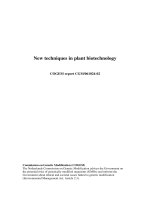Environmentally friendly techniques in Textiles
Bạn đang xem bản rút gọn của tài liệu. Xem và tải ngay bản đầy đủ của tài liệu tại đây (5.48 MB, 85 trang )
Environmentally Friendly
Environmentally Friendly
Techniques in Textiles
Techniques in Textiles
Dr Arun Kanti Guha
Dr Arun Kanti Guha
Assistant Professor
Assistant Professor
Department of
Department of
Textile Engineering, Southeast University
Textile Engineering, Southeast University
Banani, Dhaka 1213.
Banani, Dhaka 1213.
Cell:01718833461
Cell:01718833461
E-mail:
E-mail:
Prepared By : Mazadul Hasan sheshir
ID: 2010000400008
13
th
Batch (session 2009-2013)
Department : Wet Processing Technology
Email:
Blog : www. Textilelab.blogspot.com
(visit)
Southeast University
Department Of Textile Engineering
I/A 251,252 Tejgaon Dhaka Bangladesh
Prepared By :
Total Textile Process at a Glance
Introduction
Introduction
Presently garments industries have become the backbone of the
economy of Bangladesh. To support those garments industries
hundreds of full-scale textile industries have emerged in the past few
years and a lot more are going to be setup within a short time. These
textile dyeing industries are contributing in the development of
Bangladesh and at the same time are coursing serious water pollution.
It is a matter of great concern to understand and adopt adequate
treatment technologies for the remediation of this problem.
Fiber Production
Spining
Yarn Dyeing
Weaving Preparation
Weaving
Woven Processing
Garment Manufacturing
Garment Washing & Dyeing
Knitting
Knit Processing
Garment Manufacturing
Garment Washing & Dyeing
Red Mark:Effluent
Flow Chart of Textile Manufacturing
ASM Tareq Amin
ASM Tareq Amin
et al.
et al.
, BTT,
, BTT,
2009
2009
,
,
2
2
, 16
, 16
Volume of Effluent produced by the different processing of textiles.
Process Name
Weaving Prreparation
Yarn Dyeing
Knit Processing
Woven Processing
Garment Washing & Dyeing
Production /Day
4.14 million meters
150 tones
1430 tonnes
3.84 million meters
500000 pcs
1118 m
3
Effluent Quantity/Day
16,500 m
3
1,28,700 m
3
84,500 m
3
8500 m
3
Wastewater Discharged At
Wastewater Discharged At
Open Areas
Open Areas
Wastewater
Wastewater
Sample
Sample
Typical Textile Effluent Characteristics
Typical Textile Effluent Characteristics
Parameter
Parameter
Woven
Woven
Fabric
Fabric
Finishing
Finishing
Knit
Knit
Fabric
Fabric
Finishing
Finishing
Stock & Yarn
Stock & Yarn
Dyeing
Dyeing
Finishing
Finishing
Cotton
Cotton
Textile Mill
Textile Mill
Woolen
Woolen
Textile Mill
Textile Mill
Synthetic
Synthetic
Textile Mill
Textile Mill
BOD
BOD
(mg/L)
(mg/L)
550-650
550-650
250-350
250-350
200-250
200-250
760
760
900
900
50
50
COD
COD
(mg/L)
(mg/L)
850-1200
850-1200
850-1000
850-1000
524-800
524-800
1418
1418
-
-
500
500
SS
SS
(mg/L)
(mg/L)
185-300
185-300
300
300
50-75
50-75
-
-
100
100
-
-
pH
pH
7-11
7-11
6-9
6-9
7-12
7-12
9.8-11.8
9.8-11.8
9-10.5
9-10.5
7.5
7.5
MA Rahman, MS Thesis (BUET), 1997
MA Rahman, MS Thesis (BUET), 1997
Textile Effluent Characteristics: Bangladesh Perspective
Textile Effluent Characteristics: Bangladesh Perspective
Param
Param
eter
eter
Minimu
Minimu
m
m
Value
Value
Maximu
Maximu
m
m
Value
Value
BOD
BOD
(mg/L)
(mg/L)
-
-
8100
8100
COD
COD
(mg/L)
(mg/L)
16.7
16.7
17100
17100
SS
SS
(mg/L)
(mg/L)
5126
5126
15221
15221
pH
pH
3.9
3.9
11.0
11.0
MA Rahman, MS Thesis (BUET), 1997
MA Rahman, MS Thesis (BUET), 1997
Discharge Quality Standards (By DoE)
Discharge Quality Standards (By DoE)
Parameter
Parameter
Inland Surface
Inland Surface
Water
Water
BOD
BOD
5
5
(20
(20
o
o
C, mg/L)
C, mg/L)
50
50
COD
COD
(mg/L)
(mg/L)
200
200
TDS
TDS
(mg/L)
(mg/L)
2100
2100
Oil & Grease
Oil & Grease
(mg/L)
(mg/L)
10
10
pH
pH
6-9
6-9
.
.
Textile Waste Water Characterization: At
Textile Waste Water Characterization: At
City
City
University
University
Lab (2009): Area Based
Lab (2009): Area Based
Textile Waste Water Analysis
Textile Waste Water Analysis
1.
1.
Ashulia: pH 7.2, TDS (mg/L): 498 mg/L
Ashulia: pH 7.2, TDS (mg/L): 498 mg/L
2.
2.
Chittagong: pH 11.1, TDS (mg/L):1483
Chittagong: pH 11.1, TDS (mg/L):1483
3.
3.
Dhamrai: pH 6.9, TDS (mg/L): 538
Dhamrai: pH 6.9, TDS (mg/L): 538
mg/L
mg/L
4.
4.
Gazipur: pH 9.8, TDS (mg/L): 3304
Gazipur: pH 9.8, TDS (mg/L): 3304
5.
5.
Narsindi: pH 14, TDS (mg/L):3109 mg/L
Narsindi: pH 14, TDS (mg/L):3109 mg/L
6.
6.
Narayangong: pH 10.3, TDS
Narayangong: pH 10.3, TDS
(mg/L):3260
(mg/L):3260
7.
7.
Savar: pH 10.7, TDS (mg/L):3226
Savar: pH 10.7, TDS (mg/L):3226
Ashulia Chittagong Dhamrai Gazipur Narshindi Narayangong Savar
0
2
4
6
8
10
12
14
Limit: pH 6-9
Green values are environmentally freidnly
Savar
10.7
Narayangong
10.3
Narshindi
14
Gazipur
9.8
Dhamrai
6.9
Chittagong
11.1
Ashulia
7.2
pH
Area
Ashulia Chittagong Dhamrai Gazipur NarshindiNarayangong Savar
0
500
1000
1500
2000
2500
3000
3500
Limit: TDS 21OO mg/L
Green values are environmentally
friendly
Savar
3226
Nrayangong
3260
Narshindi
3109
Gazipur
3304
Dhamrai
538
Chittagong
1483
Ashulia
498
TDS (mg/L)
Area
Environmental
Environmental
Management Methods in
Management Methods in
Textiles
Textiles
1. Good House Keeping, 10-15%
1. Good House Keeping, 10-15%
2. Closer Process Control: 30-40%
2. Closer Process Control: 30-40%
Reduction in Chemical usage
Reduction in Chemical usage
Recovery & Reuse of Chemicals
Recovery & Reuse of Chemicals
Process Modification: Low liquor ratio
Process Modification: Low liquor ratio
machines
machines
Technological Development:
Technological Development:
Supercritical CO
Supercritical CO
2
2
fluid dyeing
fluid dyeing
3. Process Chemicals Substitution
3. Process Chemicals Substitution
PVA/CMC Use
PVA/CMC Use
4. ETPs
4. ETPs
Types of Effluent
Types of Effluent
Treatment Plants
Treatment Plants
1.
1.
Physicochemical
Physicochemical
2.
2.
Biological
Biological
3.
3.
Biochemical (Hybrid)
Biochemical (Hybrid)
4.
4.
Electrochemical
Electrochemical
5.
5.
Chlorine
Chlorine
ETP Diagram
ETP Diagram
Physicochemical Effluent
Physicochemical Effluent
Treatment Plants
Treatment Plants
Screening
Screening
Equalization
Equalization
pH Control (HCl/H
pH Control (HCl/H
2
2
SO
SO
4
4
)
)
Coagulation and Flocculation
Coagulation and Flocculation
(CaO, FeSO
(CaO, FeSO
4
4
/Alumn and
/Alumn and
Polyelectrolyte)
Polyelectrolyte)
Retention Time, Equalization:
Retention Time, Equalization:
for 40 m
for 40 m
3
3
/hr, 8h
/hr, 8h
Flocculation and Coagulation in
Flocculation and Coagulation in
Physicochemical Effluent
Physicochemical Effluent
Treatment Plants
Treatment Plants
Coagulation of negative particles
with positive aluminum-complex
Flocculation by entanglement with
charge-bearing polymers
Different Types of
Different Types of
Biological
Biological
Treatment Plants
Treatment Plants
Dispersed Growth:
Dispersed Growth:
Activated sludge
Activated sludge
(Retention time 48 h)
(Retention time 48 h)
Membrane Bio-Reactor
Membrane Bio-Reactor
Oxidation ditches/ponds
Oxidation ditches/ponds
Aerated lagoons, stabilization
Aerated lagoons, stabilization
ponds
ponds
Fixed Growth:
Fixed Growth:
Trickling filters
Trickling filters
Rotating Biological Contactors
Rotating Biological Contactors
(RBCs
(RBCs
)
)
Oxidation :
Oxidation :
COHNS + O
COHNS + O
2
2
+ nutrients
+ nutrients
CO
CO
2
2
+ H
+ H
2
2
O
O
+ Other end products
+ Other end products
bacteria
Typical Reactions in Biological
Typical Reactions in Biological
Processes
Processes
Organic waste is introduced into a reactor where the bacterial
culture performs the conversion of organic matter to CO
2
, H
2
O,
NH
3
and others.
Activated Sludge
Activated Sludge
Process
Process
Process in which a mixture of
Process in which a mixture of
wastewater and microorganisms
wastewater and microorganisms
is agitated and aerated
is agitated and aerated
Leads to oxidation of dissolved
Leads to oxidation of dissolved
organics
organics
After oxidation, separate sludge
After oxidation, separate sludge
from wastewater
from wastewater
Induce microbial growth
Induce microbial growth
Activated Sludge Process
Activated Sludge Process
Mixed
Liquor
in
Reactor
Air
Secondary
Clarifier
w/w
Waste
Activated
Sludge
(WAS)
Return
Activated
Sludge
(RAS)
Treated
w/w
Discharge to
River or Land
Application
Activated Sludge
Activated Sludge
Process
Process









